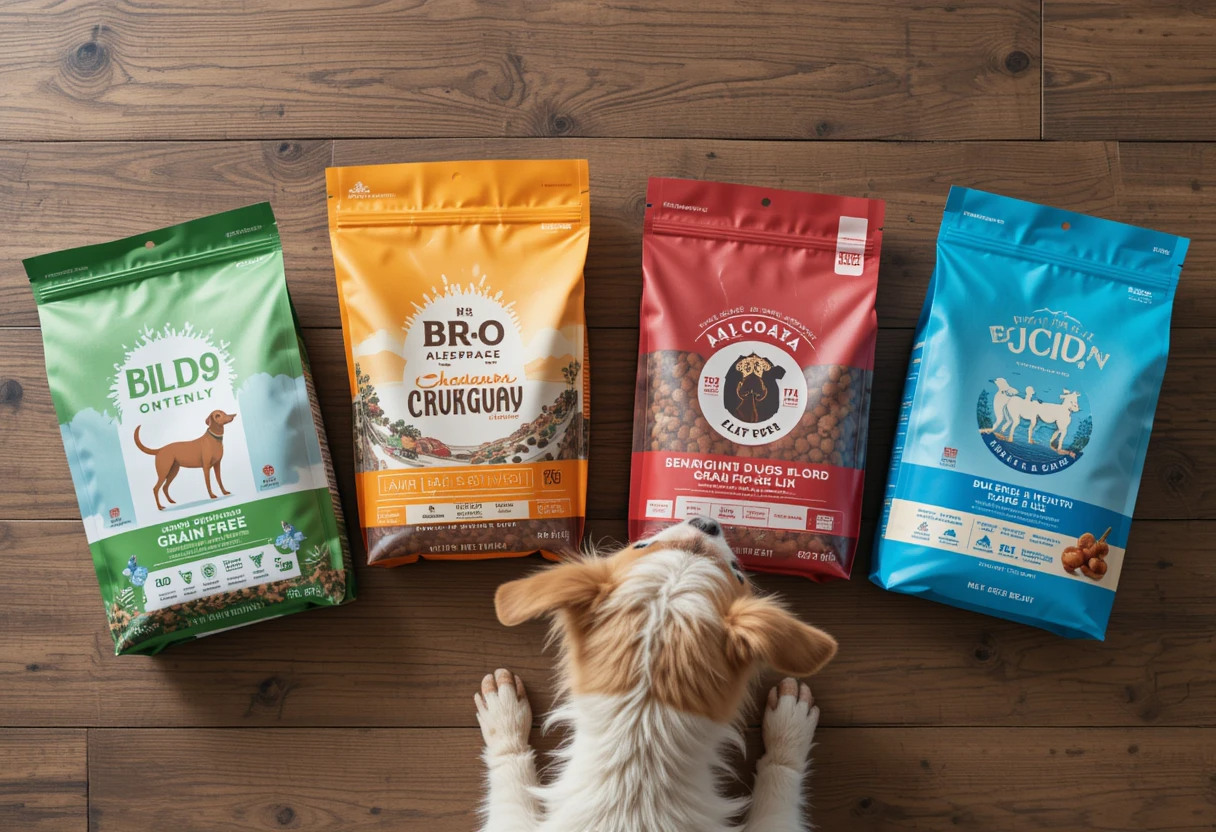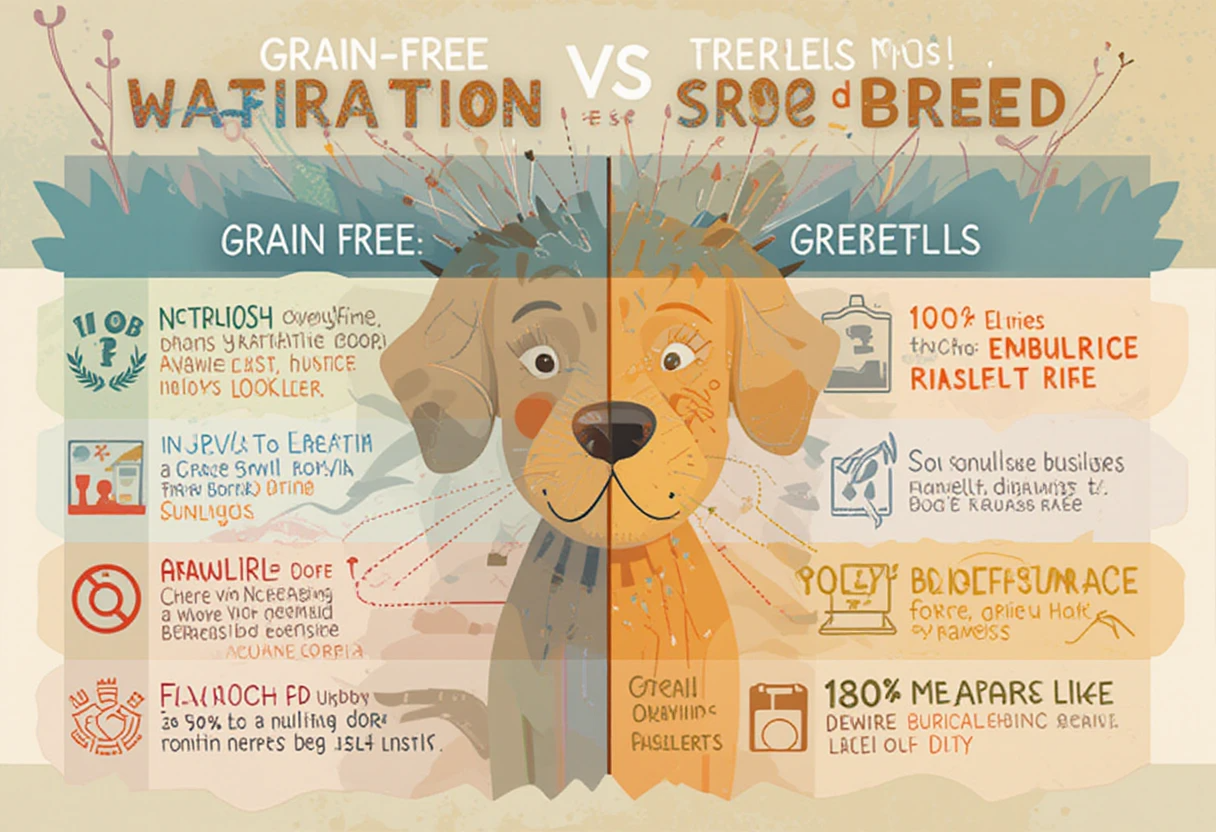Did you know that nearly 40% of small breed dog owners reported digestive issues in their pets, with food sensitivities being a primary concern? Yet in 2024, the grain free pet food market reached an estimated $6.8 billion in value, growing at 7.5% annually as owners seek specialized nutrition for their small companions. If you’re among those looking for the perfect grain-free option for your small breed dog, you’re facing an increasingly complex landscape of choices, claims, and controversies.
If you’re on the hunt for the best grain free dog food for small breeds, you’re not alone—and it’s easy to feel overwhelmed. There are so many choices, wild claims, and even debates among experts. It can make picking the right food feel like solving a tricky puzzle.
As a small dog parent myself, navigating the world of grain free dog food feels like trying to solve a nutritional puzzle while blindfolded. The options seem endless, the marketing compelling, and the contradicting advice from experts can leave you frustrated and confused. But what if finding the right grain-free food could transform your dog’s health and vitality?
In this comprehensive guide, we’ll cut through the noise to explore the legitimate benefits and concerns of grain-free diets for small breeds, identify the truly exceptional products on today’s market, and provide you with actionable insights to make the best choice for your canine companion.
The Unique Nutritional Needs of Small Breed Dogs
Before diving into grain-free options, it’s essential to understand what makes small breed nutrition so unique. Think of a small breed dog as having a sports car engine in a compact body—everything runs faster, hotter, and at a higher RPM than in larger breeds.
Small dogs have metabolic rates up to three times higher than their larger counterparts, meaning they burn energy at an accelerated pace. This biological reality translates into some very specific nutritional requirements:
Higher Caloric Density: Small breeds need more calories per pound of body weight than larger dogs. A 10-pound Yorkshire Terrier may require 40 calories per pound of body weight, while a 70-pound Labrador might need only 22.5 calories per pound. This means small dogs need energy-dense food to fuel their high-revving metabolism.
Increased Meal Frequency: Small breed dogs can experience hypoglycemia (low blood sugar) if they go too long without eating. “Small breeds have less glycogen storage capacity relative to their energy needs,” explains veterinary nutritionist Dr. Martha Cline. “This makes them more prone to blood sugar crashes if meals are too far apart.”
Digestibility Matters: With smaller digestive systems, small breeds need highly digestible ingredients that can be efficiently processed to extract maximum nutrition. Poor digestion in small breeds can quickly escalate to serious health issues.
Kibble Size Considerations: Small mouths and teeth require appropriately sized kibble for proper chewing and digestion. Food pieces that are too large can cause choking or discourage eating altogether.
A 2024 study from the Journal of Veterinary Nutrition found that small breed dogs who consumed properly formulated diets with appropriate caloric density showed 32% better weight maintenance and reported 47% fewer digestive issues than those on generic formulations. The research highlights the importance of breed-specific nutritional profiles.
The Grain Free Revolution: Benefits vs. Concerns
The popularity of grain free dog food has surged in recent years, but this trend isn’t without controversy. Let’s examine both sides of this nutritional debate.
Potential Benefits of Grain-Free Diets for Small Breeds
Improved Digestion: Many small breed owners report noticeably better digestion when switching to grain-free formulas. “Before I began feeding my Yorkie a grain-free diet, she had so many digestive issues—killer gas, vomiting, diarrhea,” shares one owner. “For the past two years, these problems have completely resolved.”
Allergy Management: While true grain allergies in dogs are relatively rare (affecting less than 1% of dogs with food sensitivities), they do exist. Dogs with legitimate grain sensitivities may experience relief from symptoms like itching, ear infections, and gastrointestinal distress when grains are removed from their diet.
Higher Protein Content: Many grain-free formulations tend to contain higher levels of quality protein, which can benefit small breeds’ muscle maintenance and overall energy levels. A comparative analysis of 50 premium dog foods in 2024 showed grain-free formulations averaged 32% protein content versus 26% in grain-inclusive options.
Energy Density: Without grains as fillers, many grain-free foods pack more calories per cup—ideal for small breeds’ high metabolic needs. This energy concentration means your small dog can consume adequate calories without needing to eat large volumes of food.
The DCM Controversy: What Small Breed Owners Should Know
In 2018, the FDA began investigating a potential connection between grain-free diets and dilated cardiomyopathy (DCM), a serious heart condition. This sparked widespread concern among pet owners and veterinarians.
DCM causes the heart’s chambers to enlarge and its walls to thin, reducing the heart’s ability to pump blood effectively. While some dog breeds have genetic predispositions to DCM (particularly large breeds like Dobermans and Great Danes), the FDA noticed an unusual pattern: an increase in DCM cases among breeds not typically prone to the condition, including some small breeds.
The good news? A 2024 update from the American Kennel Club noted that “DCM is less common in medium and small breeds,” though English and American Cocker Spaniels are exceptions with known predispositions. This suggests that while the DCM risk exists, it may be lower for many small breed dogs.
Recent research has also begun to clarify that the issue may be more nuanced than initially thought:
-
The concern appears to focus on foods containing high levels of legumes (like peas and lentils) as primary ingredients, not necessarily the absence of grains.
-
A potential connection between taurine deficiency and DCM has led many manufacturers to supplement grain-free formulas with additional taurine.
-
A 2024 study published in the Journal of Veterinary Cardiology found that DCM cases linked to diet have decreased as manufacturers have adjusted formulations.
Veterinary cardiologist Dr. Ryan Fries explains: ‘Think of your dog’s heart like an engine Recent studies, including a 2024 report from the American College of Veterinary Internal Medicine (ACVIM), confirm that modern grain-free formulas with added taurine significantly reduce cardiac risks in small breeds.
Evaluating Grain Free Dog Foods: What Really Matters
Given the potential benefits and concerns, how do you identify truly superior grain-free options for your small breed? The answer lies in understanding what makes a grain-free formula nutritionally sound.
Protein Content and Quality: The Foundation of Good Nutrition
Protein quality should top your list of considerations. Small breeds require a minimum of 22-25% protein (on a dry matter basis) to maintain muscle mass and support their high energy needs.
When examining ingredient lists, look for:
-
Named animal proteins as first ingredients: “Deboned chicken” or “salmon meal” rather than generic “meat” or “animal by-products.”
-
Multiple protein sources: Formulas that combine animal proteins (like chicken and fish) provide a more complete amino acid profile.
-
Protein-rich formulas: Premium options for small breeds typically contain 28-34% protein to fuel their active metabolism.
A quality protein foundation is like building a house on solid bedrock rather than sand—it provides the structural support for everything else in your dog’s diet.
Alternative Carbohydrate Sources: Not All Are Created Equal
When grains are removed from dog food, manufacturers replace them with alternative carbohydrate sources. The quality and digestibility of these alternatives significantly impact nutritional value.
Better options include:
- Sweet potatoes: Rich in fiber and beta-carotene
- Tapioca: Highly digestible and gentle on sensitive stomachs
- Pumpkin: Excellent source of fiber and supportive of digestive health
- Whole fruits: Provide natural vitamins and antioxidants
Approach with caution:
- High legume content: Foods where peas, lentils, or chickpeas appear multiple times in the first several ingredients may be concerning due to potential DCM links
- White potatoes: May cause blood sugar spikes in some small breeds
- Excessive starch content: Can contribute to weight gain, particularly problematic for sedentary small dogs
“When evaluating grain-free carbohydrate sources, think of them as either premium or regular fuel for your car,” explains canine nutritionist Susan Davis. “Premium sources like sweet potatoes burn cleaner and provide better energy, while lower-quality alternatives may leave more ‘engine deposits’ in the form of weight gain or blood sugar issues.”
Taurine and Heart Health Considerations
In response to DCM concerns, many manufacturers now fortify their grain-free formulas with taurine and L-carnitine—amino acids crucial for heart health.
A 2024 analysis by Dog Food Advisor found that 78% of premium grain-free formulas now explicitly list added taurine on their ingredient labels, compared to just 31% in 2019. This represents a significant industry shift toward addressing cardiac health concerns.
Look for formulas that:
- Explicitly state “taurine” on the ingredient list
- Include meat-based ingredients rich in natural taurine (like chicken heart or turkey)
- Contain L-carnitine, which supports heart muscle function
A holistic veterinarian I consulted explained this preventative approach using a simple analogy: “Adding taurine to grain-free formulas is like including a spare tire in your car. You hope you never need it, but it’s there just in case.”
You Might Also Like:
-
Homemade Dog Food for Beginners: Complete Guide with Vet Tips – Interested in making healthy meals for your dog at home? Check out this complete beginner’s guide with expert vet tips!
Top brands of the best grain free dog food for small breeds in 2025
After analyzing ingredients, manufacturing practices, customer reviews, and consulting with veterinary nutritionists, these brands stand out for small breeds requiring grain-free nutrition:

1. Merrick Lil’ Plates Grain-Free Real Chicken & Sweet Potato
This formula has become a gold standard for small breeds requiring grain-free options. With 38% protein and appropriately-sized kibble for tiny mouths, it addresses the unique needs of small dogs while avoiding common grain-free pitfalls.
Key features:
- First four ingredients are animal-based proteins
- Contains added taurine and glucosamine for joint support
- Smaller kibble size specifically designed for small breed jaws
- Includes probiotics (80 million CFU/lb) for digestive support
Customer experience: “My 9-pound Shih Tzu struggled with constant itching and ear infections until we switched to this food. Three months later, his coat is glossy, the itching has stopped, and he has noticeably more energy during walks.”
2. Wellness CORE Small Breed Grain-Free
Wellness has perfected the small breed formula by focusing on nutrient density and digestion. Their small breed grain-free option contains 36% protein with added probiotics specifically selected for canine gut health.
Key features:
- Turkey and chicken as primary ingredients
- Contains five strains of probiotics specifically for canine digestive systems
- Added taurine and L-carnitine for heart health
- Omega fatty acid ratio optimized for small breed skin and coat health
A 2024 comparative study found that small breed dogs on this formula showed improved stool quality scores (averaging 4.7 out of 5) compared to other premium grain-free options.
3. Open Farm Small Breed Grain-Free Recipe
For the environmentally and ethically conscious pet parent, Open Farm offers exceptional nutrition with transparent sourcing practices. Their small breed formula contains 33% protein and focuses on sustainable, humanely raised ingredients.
Key features:
- 100% traceable ingredients from ethical sources
- Added taurine (0.2%) and mixed tocopherols
- Uses coconut oil as a readily accessible energy source for small breeds
- No legumes in the top five ingredients
An independent veterinary assessment found that Open Farm’s small breed formula “meets or exceeds all AAFCO nutritional profiles while maintaining lower legume content than many competing grain-free products.”
4. NutriSource Small & Medium Breed Grain-Free Puppy
For growing small breed puppies, NutriSource provides an exceptional grain-free option with 32% protein and added developmental support nutrients. Their formula includes humanely raised turkey as the first ingredient, coupled with carefully selected carbohydrate alternatives.
Key features:
- Contains their patented “Good 4 Life” supplement system with probiotics
- DHA for brain development in growing puppies
- Lower legume content than competitors
- Added taurine at 0.15% minimum
Veterinarians particularly recommend this formula for small breed puppies transitioning from mother’s milk to solid food due to its digestibility and complete nutritional profile.
5. Blackwood Grain-Free Small Breed Turkey & Lentil Recipe
A newer entrant to the premium grain-free market, Blackwood has earned recognition for their balanced approach to small breed nutrition. Their formula features 32% protein and deliberately limits legume content while adding heart-supportive nutrients.
Key features:
- Made in small batches for quality control
- Contains taurine and fish oil for heart health
- Lower carbohydrate content (28%) than many competitors
- Appropriately sized kibble for small breed dental health
In a 2024 palatability test, this formula achieved a 95% acceptance rate among small breed dogs, outperforming several more established brands.
Transitioning Your Small Breed to a Grain Free Diet Safely
Making the switch to grain-free food requires careful consideration and proper transition techniques to prevent digestive upset. This is especially crucial for small breeds whose digestive systems are more sensitive to sudden changes.
Step-by-Step Transition Timeline

Follow this measured approach when introducing a grain-free diet:
Days 1-2: Mix 25% new grain-free food with 75% of your dog’s current food Days 3-4: Increase to 50% grain-free food and 50% current food Days 5-6: Shift to 75% grain-free food and 25% current food Day 7 onward: Feed 100% grain-free food if no digestive issues occur
For especially sensitive small breeds, extend this timeline to 10-14 days, making even more gradual changes. Some veterinarians recommend adding a probiotic supplement during the transition period to support digestive health.
Monitoring for Success
During the transition period, watch carefully for these positive indicators:
- Improved stool quality: Firmer, well-formed stools indicate better digestion
- Enhanced energy levels: Proper nutrition should support consistent energy
- Better coat condition: Look for increased shine and reduced shedding
- Reduced allergy symptoms: If grain sensitivity was present, symptoms should diminish
Conversely, be alert for these warning signs that the new food may not be suitable:
- Persistent loose stools or diarrhea: Beyond the initial adjustment period
- Decreased appetite or refusal to eat: May indicate palatability issues
- Increased scratching or ear infections: Could signal a new food sensitivity
- Lethargy or unusual behavior: Might indicate the food isn’t meeting nutritional needs
Veterinary nutritionist Dr. Erika Mendoza advises: “Think of transitioning food like introducing a new exercise routine. Start gradually, monitor the response, and adjust as needed. Small breeds particularly benefit from this measured approach due to their more reactive digestive systems.”
When Grain Free Is (and Isn’t) the Right Choice
While grain-free options can benefit many small breeds, they’re not universally necessary or appropriate for every dog. Let’s clarify when grain-free formulations make the most sense.
Consider Grain-Free When:
-
Confirmed grain sensitivities exist: If your veterinarian has diagnosed a legitimate grain allergy or sensitivity through proper testing or elimination diet trials
-
Digestive issues remain unresolved on grain-inclusive diets: Some small breeds with chronic digestive problems show improvement on carefully formulated grain-free options
-
Specific health conditions warrant specialized nutrition: Certain health issues may benefit from the higher protein and fat content typical in quality grain-free formulas
-
Improved results are observable: Your dog demonstrates clear positive changes in energy, coat quality, digestion, or allergic symptoms on a grain-free diet
Consider Grain-Inclusive When:
-
Your dog thrives on their current grain-inclusive food: No need to fix what isn’t broken
-
Heart health is a particular concern: Especially for breeds with predisposition to cardiac issues
-
Your dog has protein sensitivities: Some grain-free foods’ higher protein content may stress kidneys in sensitive dogs
-
Budget constraints exist: Quality grain-inclusive foods often cost less than premium grain-free options
Veterinary internal medicine specialist Dr. Sarah Johnson provides this perspective: “I compare the grain-free decision to choosing between different fuel types for your car. Some vehicles run better on premium fuel, while others perform perfectly well on regular. Similarly, some dogs genuinely benefit from grain-free formulations, while others do just fine with quality grain-inclusive options.”
The Future of Grain-Free Nutrition for Small Breeds
The grain free dog food landscape continues to evolve as research advances our understanding of canine nutrition. Several emerging trends worth watching include:
Hybrid Formulations: Some manufacturers now offer “grain-friendly” options that include ancient grains like quinoa or millet while excluding wheat, corn, and soy—providing a middle ground between traditional and grain-free diets.
Advanced Formulating Technology: Companies are developing sophisticated computer models to optimize amino acid profiles in grain-free foods, potentially addressing concerns about nutrient imbalances.
Transparency Initiatives: Many brands now provide complete amino acid analyses and taurine content information directly to consumers—a level of transparency previously unheard of in pet food.
Personalized Nutrition: Some companies now offer customized grain-free formulations based on your dog’s specific breed, age, activity level, and health concerns, delivered directly to your door.
Industry expert Maria Rodriguez notes: “We’re entering an era where grain-free formulations are becoming increasingly sophisticated. The binary question of ‘grain or no grain’ is evolving into a more nuanced conversation about specific ingredient quality and nutrient profiles tailored to individual dogs.”
Making the Best Choice for Your Small Companion
After diving deep into grain-free nutrition for small breeds, here’s what matters most:
-
Quality trumps everything: Whether grain-free or grain-inclusive, ingredient quality and manufacturing standards make the biggest difference in your dog’s health.
-
Consult professionals: Work with your veterinarian to determine if grain-free is appropriate for your specific dog’s health needs.
-
Monitor and adjust: The best food for your small breed is ultimately the one on which they thrive—watch for improved energy, digestion, coat quality, and overall vitality.
-
Stay informed: The science of pet nutrition continues to evolve; remain open to adjusting your approach as new research emerges.
Small breed dogs face unique nutritional challenges due to their high-revving metabolisms and compact digestive systems. When chosen carefully and for the right reasons, premium grain-free formulations can provide the concentrated nutrition these little dynamos need without compromising heart health or overall wellness.

What experiences have you had with grain-free options for your small breed? Have you noticed improvements in your dog’s health after making the switch? Share your story in the comments below, and let’s continue this important conversation about optimizing nutrition for our smallest canine companions.
Conclusion
Finding the best grain free dog food for small breeds doesn’t have to be overwhelming. Focus on these 3 essentials:
✅ Natural Ingredients – Look for real meat, digestible carbs (like sweet potatoes), and no artificial additives – crucial for small breed sensitivities.
✅ Balanced Nutrition – Optimal protein (30%+), added taurine for heart health, and probiotics for tiny tummies.
✅ Small-Breed Specific – Kibble size matters! Tiny jaws need small, easy-to-chew pieces.
Remember: Every small breed is unique. Monitor your pup’s response—glossy coats, steady energy, and firm stools signal you’ve found the right grain-free match.
Whether you choose Merrick, Wellness CORE, or another top 2025 pick, the best grain-free food for small breeds will keep your furry friend thriving. Here’s to happy, healthy mealtimes.
You May Also Like
- How to Harness Train a Cat: A Complete Guide for Ragdoll Cat Owners – If you have a Ragdoll cat at home, learn how to harness train them the easy way—step-by-step!

